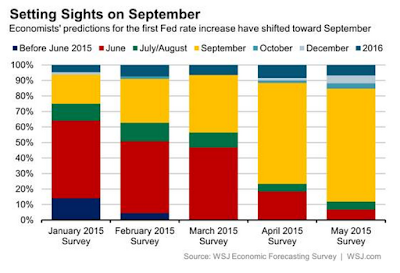
This Great Graphic comes from the Wall Street Journal. It shows the evolution of market expectations for the first Fed rate hike from the monthly survey it conducts. At the start of the year, many economists, like ourselves, thought that a June hike was the most likely scenario. However, the weakness of Q1, and especially the poor job growth in March, spurred a rethink.

The latest survey was conducted after the April jobs report was released a week ago. It found that nearly three-quarters (73%) expect a rate hike in September. We also think that is the most likely scenario.
Yellen said on more than one occasion that the Fed can hike rates at meetings that are not followed by a scheduled press conference. About 8% of those surveyed by the Wall Street Journal take the Chairwoman’s remarks at face value and expect a hike in July or October when no press conference is scheduled. Reports indicate that in April the Fed tested a system for telecommunication system to do precisely that. Still, we suspect Yellen’s comments were more about underscoring the Fed’s data-dependency rather than a true policy signal.
Indeed, if during the day of July 29, investors learn that an unscheduled press conference has been called for that afternoon, they will quickly conclude that there that the Fed will announce a rate hike and anticipate the news. To maximize the Fed’s freedom, and avoid precisely this scenario, we have recommended that the Federal Reserve adopt the practice of the ECB and BOJ in having a press conference after every meeting. We argue that this is consistent with the evolution of the Fed’s communication and increased transparency. Still, it does not appear imminent.
The Wall Street Journal found that about 7% of the respondents think that Evans and Kotcherlakota will carry the day, and there will be no lift off this year. Interesting the survey also found that 70% that the greater danger was waiting too long to hike while 30% thought the risk was going too early.















